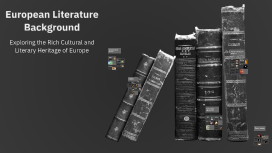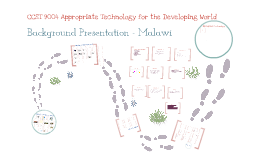European Literature Background
Transcript: European Literature Background Exploring the Rich Cultural and Literary Heritage of Europe Background of Europe Notable European Authors Historical Context Europe's history is characterized by the rise and fall of empires, transformative events like the Renaissance and the Enlightenment, and the ever-evolving political landscape. This historical backdrop has significantly influenced its cultural and literary development. Influential Empires Homer William Shakespeare Historically, Europe has seen the rise and fall of powerful empires, such as the Roman and British Empires, which have shaped political structures and cultural dynamics. These empires have left lasting legacies, influencing language, literature, and governance. Homer is traditionally credited with composing two of the most significant epic poems in Western literature, "The Iliad" and "The Odyssey." These works explore themes of heroism, fate, and the human condition, establishing foundational narrative techniques and character archetypes that persist in literature today. William Shakespeare, often revered as the greatest writer in the English language, produced a vast array of plays and sonnets. His works, including "Hamlet," "Macbeth," and "Romeo and Juliet," delve into intricate human emotions and social issues, influencing drama and poetry profoundly around the world. Geographical Overview Spanning from the Atlantic Ocean to the Ural Mountains, Europe features diverse climates, languages, and traditions. This geographical variety contributes to its cultural richness and serves as a backdrop for its literary heritage. Social and Political Movements Victor Hugo Fyodor Dostoevsky Cultural Diversity Throughout history, Europe has witnessed significant social and political movements, including the Renaissance, the Reformation, and the Industrial Revolution. These movements have challenged ideologies, transformed societies, and advanced human rights, leaving an indelible mark on literature. Victor Hugo is celebrated for his compelling storytelling and profound social commentary. Through monumental works such as "Les Misérables" and "The Hunchback of Notre-Dame," he captivated readers with themes of justice, love, and the critique of society, establishing him as a hallmark of 19th-century literature. Fyodor Dostoevsky is a pivotal figure in Russian literature, noted for his exploration of morality and existentialism. His major works, including "Crime and Punishment" and "The Brothers Karamazov," interrogate the nature of free will, guilt, and redemption, making lasting contributions to psychological and philosophical thought. Europe is home to numerous nations, each with unique languages and customs, yet they share a common historical and philosophical heritage. This cultural interplay has fostered a vibrant literary tradition that reflects diverse perspectives and experiences. Additional Influential Authors Conclusion Beyond these titans, European literature encompasses a diverse array of authors such as Goethe, Cervantes, and Kafka, whose works reflect various cultural and historical contexts. Each contributed unique narrative styles and thematic depth that resonate with contemporary literature, enhancing Europe’s literary landscape. The legacy of these notable European authors underscores the profound impact of literature on culture and society. Their works continue to inspire, challenge, and engage readers, establishing timeless themes and questions that remain relevant today. European Literature Definition and Scope Historical Development The evolution of European literature can be traced from ancient epic poetry through the Middle Ages and into the modern era. Significant movements such as the Renaissance and Enlightenment dramatically transformed literary forms and themes, laying the groundwork for contemporary expressions. European literature refers to a wide range of written works produced in Europe, spanning various genres and styles from ancient texts to contemporary writings. It reflects the complex interactions between different cultures and languages across the continent, creating a rich tapestry of literary expression. Major Themes National Traditions and Influence Common themes in European literature include exploration of human nature, societal values, and moral dilemmas. Literary works often reflect historical contexts, examining individual struggles, political ideals, and the complexities of identity across cultures. European literature is characterized by distinct national traditions, each contributing unique languages, styles, and cultural narratives. Interactions among these traditions fostered cross-border influences, enriching the overall literary landscape of the continent. Interaction with Social Changes European literature has continuously interacted with social changes, reflecting shifts in political thought, cultural movements, and technological advancements. From the Enlightenment's emphasis on reason to Romanticism's

















